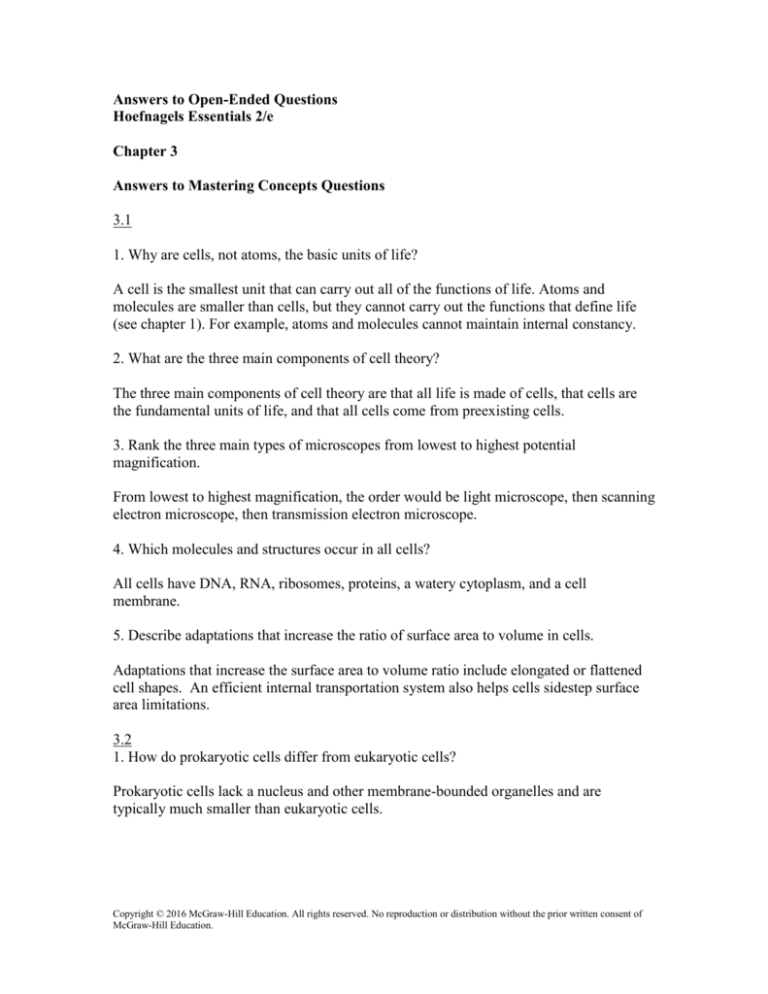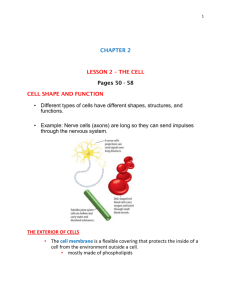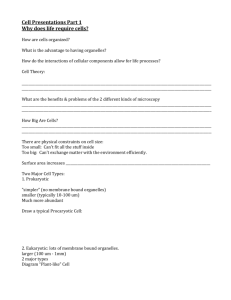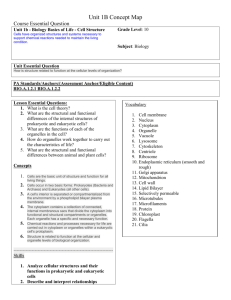
Answers to Open-Ended Questions
Hoefnagels Essentials 2/e
Chapter 3
Answers to Mastering Concepts Questions
3.1
1. Why are cells, not atoms, the basic units of life?
A cell is the smallest unit that can carry out all of the functions of life. Atoms and
molecules are smaller than cells, but they cannot carry out the functions that define life
(see chapter 1). For example, atoms and molecules cannot maintain internal constancy.
2. What are the three main components of cell theory?
The three main components of cell theory are that all life is made of cells, that cells are
the fundamental units of life, and that all cells come from preexisting cells.
3. Rank the three main types of microscopes from lowest to highest potential
magnification.
From lowest to highest magnification, the order would be light microscope, then scanning
electron microscope, then transmission electron microscope.
4. Which molecules and structures occur in all cells?
All cells have DNA, RNA, ribosomes, proteins, a watery cytoplasm, and a cell
membrane.
5. Describe adaptations that increase the ratio of surface area to volume in cells.
Adaptations that increase the surface area to volume ratio include elongated or flattened
cell shapes. An efficient internal transportation system also helps cells sidestep surface
area limitations.
3.2
1. How do prokaryotic cells differ from eukaryotic cells?
Prokaryotic cells lack a nucleus and other membrane-bounded organelles and are
typically much smaller than eukaryotic cells.
Copyright © 2016 McGraw-Hill Education. All rights reserved. No reproduction or distribution without the prior written consent of
McGraw-Hill Education.
2. Compare and contrast bacteria and archaea.
Bacteria and archaea are small cells that lack nuclei and membrane-bounded organelles.
The two groups differ in the composition of the cell wall and the lipids in the cell
membrane.
3. How do organelles contribute to efficiency in eukaryotic cells?
Organelles contribute to efficiency in eukaryotic cells by concentrating the biochemicals
needed for chemical reactions so that the reactions proceed more rapidly. Also, because
of organelles, a eukaryotic cell can maintain high concentrations of each biochemical
only in certain areas, not throughout the cell, thereby reducing the total amount of
biochemical that the cell must synthesize and maintain.
3.3
1. How does the chemical structure of phospholipids enable them to form a bilayer in
water?
The hydrophilic heads are attracted to water, whereas the hydrophobic tails avoid water.
When many phospholipids join, the hydrophilic heads align facing the water, and the
hydrophobic tails align away from water. The result is a bilayer.
2. Where in the cell do phospholipid bilayers occur?
Phospholipid bilayers form the boundaries of organelles within the cell. They also occur
at the cell’s surface as the plasma membrane.
3. What are some functions of membrane proteins?
Membrane proteins include transport proteins that move substances into and out of cells;
enzymes that facilitate chemical reactions; recognition proteins that allow the body to
recognize its own cells; adhesion proteins that stick cells together; and receptor proteins
that bind molecules outside the cell and trigger chemical reactions inside the cell.
4. How does a cell membrane differ from a cell wall?
All cells have a cell membrane, which is made of a delicate phospholipid bilayer with
selective permeability. A cell wall is a rigid structure that surrounds the cell membrane in
some cells.
3.4
1. How do organelles help eukaryotic cells compensate for a small ratio of surface area to
volume?
Copyright © 2016 McGraw-Hill Education. All rights reserved. No reproduction or distribution without the prior written consent of
McGraw-Hill Education.
One way to compensate for a small ratio of surface area to volume is to use resources and
energy efficiently. Thanks to specialized organelles, a eukaryotic cell needs to produce
high concentrations of biochemicals only in certain areas rather than producing them
throughout the cell.
2. Which parts of the cell interact to produce and secrete a complex substance such as
milk?
The nucleus, rough ER (dotted with ribosomes), smooth ER, and Golgi apparatus are
organelles involved in the production and secretion of milk. Mitochondria provide the
necessary energy.
3. What is the function of the nucleus and its contents?
The nucleus contains DNA (the molecule that contains the instructions for making
proteins) and the nucleolus (where ribosomes are assembled). Messenger RNA (mRNA)
molecules are synthesized in the nucleus before they exit to the cytoplasm through
nuclear pores.
4. Which organelles are the cell’s “recycling centers”?
Lysosomes, vacuoles, and peroxisomes are the cell’s recycling centers.
5. How are the functions of plastids essential to the life of a plant cell?
Chloroplasts are plastids that carry out photosynthesis. Other plastids store pigments or
food, or they help a plant to detect gravity.
6. Which organelle houses the reactions that extract chemical energy from nutrient
molecules?
Mitochondria house the reactions that extract chemical energy from nutrient molecules.
7. Describe how form fits function for three organelles.
Answers will vary; listed here are sample answers for a Golgi apparatus, a lysosome, and
a mitochondrion.
The Golgi apparatus is a series of flat, membrane-enclosed sacs that is the “processing
center” of the cell. It functions somewhat like an assembly line, with each sac moving a
molecule closer to its final form. Each sac has different enzymes that help carry out the
reactions.
Lysosomes are membrane-enclosed spheres that degrade and recycle materials in the cell.
The membrane can take in and release materials, and it encloses a solution of enzymes
that can dismantle organic molecules. The enzymes work most efficiently at the acidic
Copyright © 2016 McGraw-Hill Education. All rights reserved. No reproduction or distribution without the prior written consent of
McGraw-Hill Education.
pH of the lysosome rather than at the neutral pH of the cytosol, so the organelle can
degrade debris without harming the rest of the cell.
Mitochondria house the reactions that convert the energy from food into a form that the
cell can use. Each mitochondrion has a highly folded inner membrane, which provides
enormous surface area for the reactions that occur within the membrane. The inner
membrane also provides a separate compartment—the matrix—within the organelle
where additional reactions can occur.
3.5
1. What are some functions of the cytoskeleton?
The cytoskeleton provides a structural framework for the cell, is a transportation system
within the cell, allows the cell to move, and connects cells together.
2. What are the main components of the cytoskeleton?
The major components of the cytoskeleton are microfilaments, intermediate filaments,
and microtubules.
3. Why are cilia and flagella important?
Unicellular organisms may use either flagella or cilia to move toward food or other
resources. Both cilia and flagella are important to human reproduction. The whiplike
movement of a human sperm cell’s flagellum propels the sperm toward the egg cell.
Waving of cilia on cells lining the female reproductive tract propel the egg cell through
the uterine tube. Other cells in humans and other animals also have cilia, which typically
propel particles through tubes (such as sweeping dust out of the respiratory tract.)
3.6
1. What are the functions of a cell wall?
Cell walls provide rigidity, prevent a cell from bursting if it takes in too much water, and
allow interactions with other cells.
2. What is the chemical composition of a plant cell wall?
Plant cell walls are made of cellulose and other polysaccharides.
3. What are plasmodesmata?
Plasmodesmata are tunnels in the cell walls that connect adjacent plant cells.
4. What are the three types of junctions that link cells in animals?
Tight junctions, anchoring junctions, and gap junctions link cells in animals.
Copyright © 2016 McGraw-Hill Education. All rights reserved. No reproduction or distribution without the prior written consent of
McGraw-Hill Education.
Answers to Write It Out Questions
1. How did microscopes contribute to the formulation of the cell theory?
The first microscopes allowed early scientists to view cells in cork and to learn that all
organisms are made of cells. As the technology advanced, scientists could see the
internal structures within cells. New microscopes have allowed scientists to view the cells
in much greater detail. Scientists now understand much more about what cells are made
of, how they use energy, and how they divide.
2. List the features that all cells share, then name three structures or activities found in
eukaryotic cells but not in bacteria or archaea.
All cells have: DNA, RNA, protein, ribosomes, cytoplasm, and a cell membrane.
Structures or activities found only in eukaryotic cells include any of the organelles, a
nucleus, or the activities of the endomembrane system.
3. If a eukaryotic cell is like a house, how is a prokaryotic cell like a one-room
apartment?
A eukaryotic cell is like a house with many different internal compartments and
specialized areas. A prokaryotic cell is more like an efficiency apartment because it is
smaller and has a simpler structure with fewer internal compartments. However, the
apartment still carries out the same basic functions as the house.
4. List three structural differences between plant and animal cells. Explain how each
structural difference reflects a functional difference between plants and animals.
Plant cells have chloroplasts; animal cells do not. Chloroplasts are the organelles where
photosynthesis occurs. Animals are heterotrophs and do not carry out photosynthesis.
A plant cell also has a central vacuole, a sac that occupies most of the cell’s volume;
animal cells do not. Turgor pressure exerted by the vacuole on the cell wall helps a plant
stay upright.
5. Suppose you find a sample of cells at a crime scene. What criteria might you use to
determine if the cells are from prokaryotes, plants, or animals?
One approach would be to look at the cells with a microscope. If they lack a nucleus, they
are prokaryotic; if they contain a nucleus, they are eukaryotic. A eukaryotic cell with a
cell wall is likely to be a plant cell (although it could also come from a fungus or some
types of protists). A eukaryotic cell without a cell wall is likely to come from an animal
(although it could also belong to a protist).
Copyright © 2016 McGraw-Hill Education. All rights reserved. No reproduction or distribution without the prior written consent of
McGraw-Hill Education.
6. Rank the following in order from smallest to largest: ant, prokaryotic cell, actin
molecule, microtubule, nitrogen atom. What type of microscope (if any) would you need
if you wanted to see each?
From smallest to largest, the order would be nitrogen atom, actin molecule, microtubule,
prokaryotic cell, ant. The nitrogen atom and individual actin molecule are too small to see
with any microscope. Microtubules and prokaryotic cells are best seen with an electron
microscope, although they are visible with a light microscope. An ant is visible with the
unaided eye.
7. Which has a greater ratio of surface area to volume, a hippopotamus or a mouse?
Which animal would lose heat faster in a cold environment and why?
A mouse has a higher surface area to volume ratio and would lose heat more quickly. The
body of the mouse is in greater contact with the cold environment than the hippopotamus.
The mouse also has less muscle volume to generate replacement heat.
8. List the chemicals that make up cell membranes.
The chemicals in cell membranes are phospholipids, steroids, proteins, and sugars.
9. Compare and contrast the phospholipid bilayer with two pieces of Velcro sticking to
each other.
The two pieces of Velcro have the fabric backing sandwiching the hooks and loops
inside, similar to the phospholipid tails sandwiched between the two layers of heads. The
backing (not able to attach) and the hook and loops (able to attach) are different, just as
tails are hydrophobic and heads are hydrophilic. However, what holds the two pieces of
Velcro together are actual attachments between the hooks and loops; the phospholipids
tails do not attach to each other, they just orient themselves based on their ability to repel
water.
10. One way to understand cell function is to compare the parts of a cell to the parts of a
factory. For example, the Golgi apparatus would be analogous to the factory’s shipping
department. How would the other cell parts fit into this analogy?
The nucleus would be the management office where product orders are issued, and the
ribosomes and smooth ER would be the sites of production. The forklifts would be
transport vesicles carrying raw materials and products within the factory, and the power
generators would be the mitochondria. The girders and steel beams that make up the
structure of the building would be the cytoskeleton.
11. Choose an organelle in a human cell, and imagine that a disease causes that organelle
to be faulty. How would the malfunctioning organelle affect the cell’s function?
Copyright © 2016 McGraw-Hill Education. All rights reserved. No reproduction or distribution without the prior written consent of
McGraw-Hill Education.
Answers will vary; these are two examples. If mitochondria were affected, a cell would
be unable to generate energy. If the endoplasmic reticulum were to malfunction, many
other organelles (such as lysosomes and peroxisomes) would not function properly
12. Why does a muscle cell contain many mitochondria? Why does a white blood cell
contain many lysosomes?
Muscle cells require a lot of energy to move parts of the body; mitochondria use aerobic
cellular respiration to extract energy from food. White blood cells have many lysosomes
because they engulf and dispose of debris and bacteria.
13. List the components and functions of the cytoskeleton.
Three components of the cytoskeleton are microfilaments, intermediate filaments, and
microtubules. The cytoskeleton forms a transportation system, provides structural support
necessary to maintain the cell’s characteristic three-dimensional shape, enables cells or
parts of the cells to move, aids in cell division, and helps connect cells to one another.
14. Describe how animal cells use junctions in different ways.
Tight junctions create a seal between adjacent cells. Anchoring junctions are “spot
welds” that secure cells in place. Gap junctions allow adjacent cells to exchange
cytoplasmic material.
15. Chapter 1 explains emergent properties and describes the characteristics of life. Use
this information to explain why life is an emergent property that appears at the level of
the cell.
All life is organized; requires energy; maintains internal constancy; reproduces, grows,
and develops, and evolves. Molecules are smaller than cells and are not considered alive
because they do not require energy, maintain internal constancy, or grow. However, when
many molecules interact in a cell, all of the characteristics of life emerge. Lipids,
proteins, and sugars form the membrane that encloses the cell and helps it to maintain a
constant internal environment. The cell grows as proteins and nucleic acids interact to
synthesize new proteins, which in turn synthesize other structures. The many reactions
occurring within a cell require energy.
Copyright © 2016 McGraw-Hill Education. All rights reserved. No reproduction or distribution without the prior written consent of
McGraw-Hill Education.
Answers to Pull It Together Questions
1. How might you connect the terms proteins and cytoskeleton?
“Proteins” could connect with the phrase “make up the” to “cytoskeleton.”
2. Write the distinguishing features of domain Bacteria and domain Archaea on the
concept map.
The cell membrane of a bacterium is composed of fatty acids, whereas the cell membrane
of an archaean is composed of nonfatty acid lipids. The two groups also differ in certain
key genetic sequences.
3. How do a cell’s organelles interact with one another?
Each organelle does only part of the work of the cell: the nucleus stores information,
ribosomes produce proteins, mitochondria produce energy, and so on. Vesicles, or small
bubbles of membrane, carry proteins and other substances from one organelle to another.
Since each organelle has specific functions, vesicles allow organelles to divide tasks
among each other. The production of milk, as described in the chapter, is a good
illustration of how organelles use vesicles to interact.
4. Add cytosol, chloroplast, lysosome, and vacuole to this concept map.
“Cytosol” could connect with the phrase “is the fluid portion of” to “Cytoplasm.” The
other terms could be connected in many ways. One possibility would be to first add
“Plants” and “Animals” as kingdoms within domain Eukarya. Then, “Chloroplast” and
“Vacuole” could be listed as organelles found in the cells of plants, and “Lysosome”
could be listed as an organelle found in the cells of animals.
3. Add the eukaryotic kingdoms of life to this concept map.
All the eukaryotic kingdoms (Protists, Fungi, Plantae, and Animalia) should be listed
under Domain Eukarya with the connecting phrase “contains these kingdoms”.
4. Which structures occur in plant cells but not animal cells?
Plant cells have chloroplasts, a central vacuole, and a cell wall.
5. What is the relationship between the cytoplasm and the cytoskeleton, ribosomes, and
organelles?
The cytoplasm includes all parts of the cell within the cell membrane except for the
nucleus. The cytoplasm is therefore the cytoskeleton, ribosomes, and most organelles, as
well as the fluid portion of the cell (the cytosol).
Copyright © 2016 McGraw-Hill Education. All rights reserved. No reproduction or distribution without the prior written consent of
McGraw-Hill Education.










